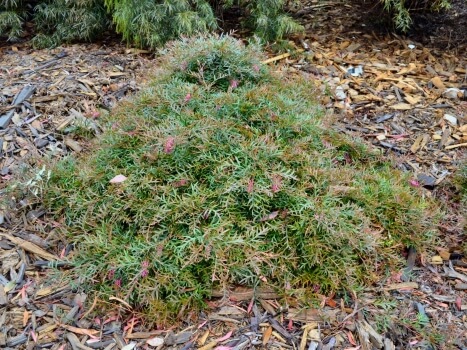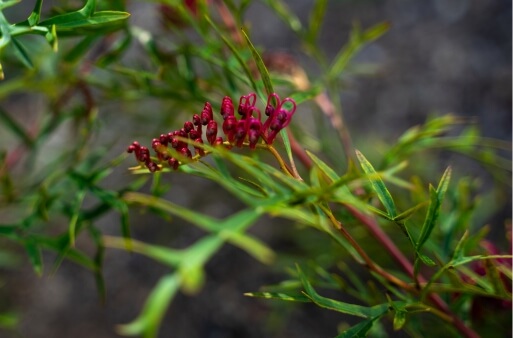The low-growing Grevillea ‘Bronze Rambler’ is one of the most exciting hybrids in the Grevillea genus. Its flowers are subtle, but add winter colour to borders and open spaces, while the new growth is strikingly coloured, emerging on red stems which host fresh green foliage.
To grow your own Grevillea ‘Bronze Rambler’, all you need is space, a bucket of good compost, and a spade. So let’s get started.
More...

Family: | Proteaceae |
|---|---|
Genus: | Grevillea |
Hybrid: | G. rivularis and G. ‘Poorinda Peter’ |
Origin: | Australia |
Common Names: | Grevillea ‘Bronze Rambler’ |
Location: | Outdoor |
Type: | Trailing shrub |
Growth: | H 30cm x W 2m |
Sun requirements: | Full sun |
Foliage Colour: | Green |
Flower Colour: | Vermillion |
Flowering: | Predominantly from winter to spring |
Fruit: | None |
Maintenance level: | Low |
Poisonous for pets: | Non-toxic to cats and dogs |
Introducing Grevillea ‘Bronze Rambler’
Grevillea ‘Bronze Rambler’ is a hybrid between Grevillea rivularis and Grevilliea ‘Poorinda Peter’. G. rivularis (Carrington Falls grevillea) is threatened in its natural habitat, but its striking foliage is well represented in its trailing offspring, while the selectively bred Grevillea ‘Poorinda Peter’ lends its flower form and sprawling habit to Grevillea ‘Bronze Rambler’.

Source: Virginia Nursery
Natural Habitat of Grevillea ‘Bronze Rambler’
Like all grevilleas, Bronze Rambler has its origins in Australian soil, but as a man made hybrid, it is not actually native to anywhere. Thankfully, with its mixed parentage, it is very well suited to Australian gardens, and grows well in almost all parts of the country.
How to Grow Grevillea ‘Bronze Rambler’
Grevilleas are native plants, preferring full summer sun, but able to cope with some shade. Over winter, this plant can be left outside even in frosty parts of the county as it is fully frost-hardy.
Plant Grevillea ‘Bronze Rambler’ into enriched soil to get it off to the best start, preparing a planting hole that is twice the size of its root ball. Loosen the soil at the base of the hole and mix compost back through the soil before in-filling around the roots.
Note: Propagating Grevillea ‘Bronze Rambler’ is surprisingly simple. Check out our guide to growing Grevilleas for a guide on seed and cutting propagation.

Source: Gardening with Angus
Soil & Drainage
Choose a spot with good drainage. Like all grevilleas, Grevillea ‘Bronze Rambler’ will suffer from damp problems, root rot, and fungal infection in overly wet soil. If you have a damp garden, you can still grow Grevillea ‘Bronze Rambler’ in pots to provide drier conditions.
There is little need for fertiliser after initially planting with some compost to support initial root growth, but if you notice yellowing or crisping leaves as a result of nutrient deficiency, add phosphorus to the soil, either through organic feed or any basic native plant fertiliser.
Light & Temperature
Grevillea ‘Bronze Rambler’ is a big sun-lover, and prefers to be in full sun, though thankfully, as a low-growing shrub, it does actually cope quite well with some afternoon shade, making it a useful plant for understory planting around the base of trees, or near fences, where it can come with slightly less sunlight than most grevillea species.
Caring for Grevillea ‘Bronze Rambler’
Grevillea ‘Bronze Rambler’ doesn’t take much care once established. In very, very dry summers, you can support continued flowering with a little bit of extra water (a bucket per week in summer is sufficient).
The aim with these grevilleas is to try to encourage year-round flowering. While they do naturally flower all year round, they will usually put their efforts into a big winter and spring display, followed by a weak summer and autumn bloom.


Get Your Free Guide:
Master Growing Australian Natives eBook
A Must Have Complete Guide for Every Australian Garden
Get Your Free Guide:
Master Growing Australian Natives eBook
A Must Have Complete Guide for Every Australian Garden
To boost flowering, increase watering and feed with phosphorus-rich fertiliser in later spring to encourage a second flush. In very dry conditions where dry winter soil is likely, add a layer of basic mulch to lock in moisture (spent compost is fine for this, as it’s for moisture, not nutrients).
Grevillea ‘Bronze Rambler’ Pests and Diseases
Grevillea ‘Bronze Rambler’ is more susceptible to sooty mould and fungal problems than most grevilleas, largely because their growth is dense and close to the ground, where humidity can be higher during wet summers.
Ensure you plant your grevillea on well-drained soil to avoid these simple problems, and improve drainage where possible when you notice signs of fungal infections.
Grevillea ‘Bronze Rambler’ Frequently Asked Questions

Does Grevillea ‘Bronze Rambler’ spread?
Grevillea ‘Bronze Rambler’ spreads well across large borders, and will help to fill out challenging spots in the garden with highly ornamental foliage and vivid flowers. While it will grow up to about 1m in some cases, it typically grows to 30cm tall and spreads out to 2m per plant, spreading by roots in manageable ways.
How hardy is Grevillea ‘Bronze Rambler’?
Grevillea ‘Bronze Rambler’ is hardy in every part of Australia. It grows well in colder regions, but may suffer if exposed to prolonged damp in winter, so find a spot with reasonable drainage.
How long does Grevillea ‘Bronze Rambler’ take to mature?
Grevillea ‘Bronze Rambler’ can continue spreading for its first ten years, but will reach a near-mature size after five years.
Check out this article for more Grevillea ground cover varieties.
Wrapping Up Our Grevillea ‘Bronze Rambler’ Growing Guide
Grevilleas are iconic Australian plants and, like most natives, they offer a mix of structural interest, captivating foliage, and striking flowers. Grevillea ‘Bronze Rambler’ has all of that and more, offering uniquely formed ground cover with the hardiness and stability that we expect from Grevillea.
Growing your own Grevillea ‘Bronze Rambler’ couldn’t be easier, so grab a spade and get gardening. In a few months, you’ll have a gorgeous and well-established plant, which will only get better with time.
Published on April 10, 2023 by Nathan Schwartz
Last Updated on February 23, 2024




